Boggs S. Principles of Sedimentology and Stratigraphy
Подождите немного. Документ загружается.


4.2 Kinds Primary Sed imentary Structures
75
4.2 KI NDS OF PRIMARY SEDIMENTA RY STRUCTURES
e most common and abundant primary sedimentary structures are listed in
Table 4.1. This listing is fundamentally descriptive; that , it is based primaly
upon observable properties. Sedimentary structures are grouped into three broad
categories: stratificaon structures and bedforms, bedding-plane markings, and
other structures. Stratification structures and bedforms are furer subdivided into
four descriptive categories: bedding and laminaon, bedforms, cross-satification,
and irregular stratification. Primary sedimentary structures are generated by four
ndamental kinds of processes: (1) mainly deposition (depositional structures),
(2) processes that involve an episode of erosion followed by deposition (erosional
suctures), (3) deposition followed by physical soft-sediment deformation (defor
mation structures), and (4) biogenicay mediated deposition or nonbiogeneic de
posion followed by biogenic modification (biogenic structures). e inset in
Ta ble 4.1 shows the relationship between sedimentary processes and the kinds of
simentary structus formed.
STRATIFICATION AND BEDFORMS
Planar bedding and lamination
Laminated beddin�L
2
·3
Graded bedd
g
l,l
Massive (structureless) bedding1
•
1
2
Bedforms
RipplesL2
Dunes1•2
tidunes1
Cross-stratification
Cross-bedding1•2
Ripple cross-lam
ation1•2
Flaser and lticular bedding1
Hummocky cross-stratification1
Irgular stratification
Convolute bedding and lamination7
Flame structures7
Ball and pillow structures7
Synsedimentary folds and faults6
Dish and pillar structures 9
Channels4
Scour-and-fill structures4
Mottled bedding12
Stmatolites13
BEDDING-PLANE MARNGS
Groove casts; striations; bounce, brush,
prod, and roll marks5
Flute casts4
Parting lineation1
Load casts7
Tracks, ails, burrows
1
2
Mudcracks and syneresis cracks10
Pits and small impressions11
Rill and swash marks1
OTHER STRUCTURES
Sedimentary sills and dikes8
Depositional Suctures
1. Suspension settling and currt- d
wave-formed structures
2. Wind-formed structures
3. Chemically and biochemically formed
structures
Erosional Suctures
4. Scour marks
5. Tool marks
Deformation Structus
6. Slump structures
7. Load and founder structures
8. Injection (fluidization) structures
9. Fluid-escape suctures
10. Desiccation structures
11. Impact structures {ra, hail, spray)
Biogenic Structures
12. Bioturbation structures
13. Biosatification structures

76
Chapter 4 I Sedimenta Structures
Fi 4.1
4.3 STRATIFICAT ION AND BEDFORMS
Bedding and Lamination
Nare of Bedding
Bedding is a fundamental characteristic of sedimentary rocks. Beds are tabular or
lencular layers of sedimentary rock that have lithologic, textural, or structural
unity that dearly distinguishes them om strata above and below. The upper and
lower surfaces of beds are known as bedding planes or bounding planes. Otto
(1938) regarded beds as sedimentation units; that is, as the thickness of sediment
deposited under essentially constant physical conditions. It is not always possible,
however, to identify individual sedimentation units. Many beds defined by e
criteria stated may contain several true sedimentaon units. Beds are defined as
strata thicker than 1 em (McKee and We ir, 1953); layers less than 1 em thick are
called laminae. Terms used for describing the thickness of beds and laminae are
shown in Figure 4.1.
Beds can be dferentiated inteally into a number of informal units (Fig. 4.2).
A single bed may contain subdivisions arising from distinctive associations of
sedentary structures, such as plane laminae or ripple laminae. Also, thin units
of dierent composition, texture, cementation, or color, such as a lens of pebbles
or a band of chert, may be present. A marked discontinuity (commonly an erosion
al surface) between two beds of similar composition is called an amalgamation
suace, and beds separated by such surfaces are called amalgamated beds. e
term layer is used in a loose, informal sense for any bed or stratum of rock. The
term has also been used in a more formal sense but usage is not consistent. For ex
ample, Blatt, Middleton, and Murray (1980) suggest that layers are parts of a bed
thicker an laminae that are separated by minor but distinct discontinuities
texture or composition. the other hand, Ricci Lucchi (1995) uses the term in e
sense of a sedimentation unit (Otto, 1938); thus, according to Ricci Lucchi, a layer
can include two or more beds.
Beds are separated by bedding planes or bedding surfaces, most of which
represent planes of nondeposition, an abrupt change in composition (which reflect
changes in depositional conditions), or an erosion surface (Campbell, 1967). Some
bedding surfaces may be postdepositional featus formed by diagenetic processes
Beds
Ve thick bed
100
Thick b
E
30
$
Mium b
10
.2
:
Te rms used for describing the thickness of beds and laminae.
[Modified from McKee, E. D., and G. W. Weir, 1953, Te rminolo
gy for stratification and cross-stratification in sedimentary rocks;
Geol. Soc. America Bull., v. , Table 2, p. 383; and Ingram, R.
l., 1954, Te rminology for the thickness of stratification and part
ing units in sedimentary rocks: Geol. Soc. America Bull., v. 65,
Fig. 1, p. 937.]
3
Thin bed
Ve thin b
Lamina
/
/
/
/
Lamina
E
10
/
Thick Lamina
�
3
Thin lamina
.9
�
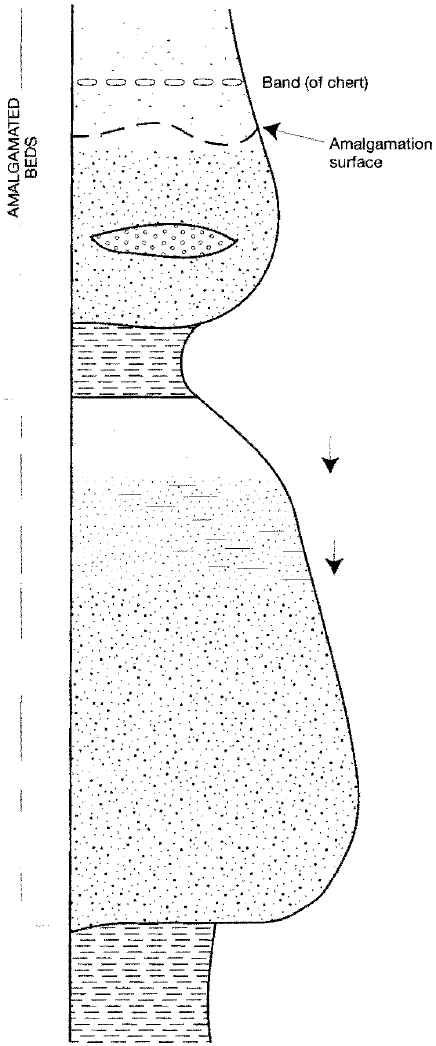
t
I
l
. --
l
_y_
Lens (of pebbles)
t
Subdivision (of
ripple laminae)
t Subdivision (of
plane laminae)
Flgure 4.2
4.3 Stratification and Bedforms
77
Informal subdivision of beds on the basis of inteal struc
tures. Based in part on Blatt, Middleton, and Murray
(1980, Origin of sedimentary rocks, 2nd ed.: Prentice-Hall,
Inc., Englewood Cliffs, Fig. 5.1, p. 130).
or weaering. The gross geometry of a bed depends upon the relationship be
een bedding surfaces. The bottom and top surfaces of beds are commonly par
allel to each other; however, some bedding surfaces are nonparallel (Fig. 4.3). The
bedding surfaces themselves may be even, wavy, or curved. Depending upon the
combination of ese characteristics, beds can have a variety of geometric forms
such as uniform-tabular, tabular-lenticular, curved-tabular, wedge-shaped, and ir
ular. The interior of beds (the interval between bedding planes) may conta lay
e d laminae that are essentially parallel to the bedding planes; that is, beds may
display inteal planar stratification or laminated bedding. Layers and laminae at
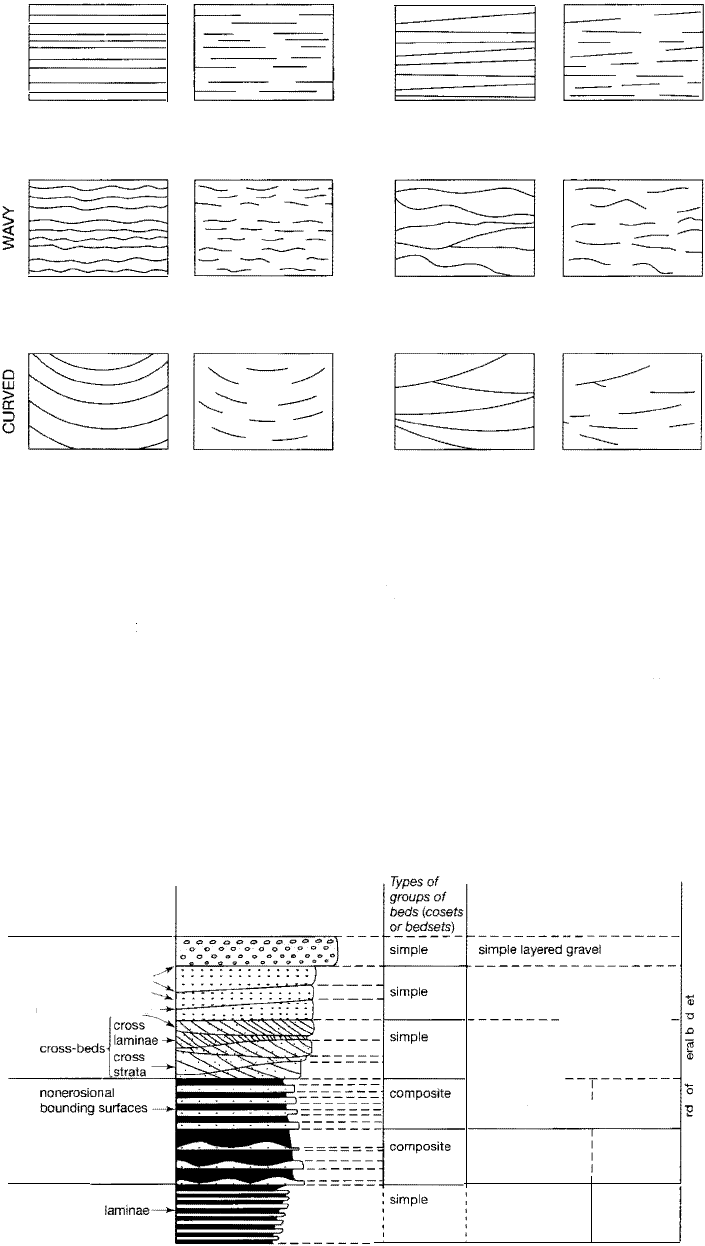
78
C
hapter 4 I Sedimentary Structures
Figure 4.3
Descriptive terms used for
the configuration of bedding
surfaces. [From Campbell, C.
V., 1967, Lamina, laminaset,
bed and bedset: Sedimentol
ogy, v. 8, Fig. 2, p. 18,
reprinted by permission of El
sevier Science Publishers,
Amsterdam.]
Figure 4.4
Diagram illustrating the ter
minology of bedsets. [From
Collinson, ). D., and D. B.
Thompson, 1982, Sedimen
tary structures: George Allen
& Unwin, London, Fig. 2.2,
p
.
8.]
z
w
>
w
PARALLEL
Even, parallel
Wavy, parallel
Curved, parallel
Discontinuous,
even, parallel
Discontinuous,
wavy, parallel
Discontinuous,
curved, parallel
NONPARALLEL
Even, nonparallel
Wavy, nonparallel
Curved, nonparallel
Discontinuous,
even, nonparallel
Discontinuous,
wavy, nonparallel
Discontinuous,
curved, nonparallel
make up the internal structure of some beds are deposited at an angle to the
bounding surfaces of the bed and are, therefore, called cross-strata or cross-lamina.
Beds composed of cross-stratied or cross-laminated units are called cross-beds.
The bounding surfaces of cross-beds may be either parallel or nonparallel.
Groups of similar beds or cross-beds are called bedsets. A simple bedset
consists of two or more superimposed beds characterized by similar composition,
texture, and inteal structures. A bedset is bounded above and below by bedset
(bedding) surfaces. A composite bedset refers to a group of beds differing in com
position, texture, and internal structures but associated genetically, representing a
common type of deposited succession (Reineck and Singh, 1980). The terminology
of bedsets is illustrated in Figure 4.4.
Grain
Structure and
size
features
gravel
layers
or strata
Individual bed
limits
sand {bedding planes and
.
bounding surfaces
layers and laminae
' erosional bou,ndinQ ....
tsurfaces
sand
silty mud
silt - mud
increasing
grain size.
mud ·· wavel
Bedding type
plane laminated sand
"
---------
v
simple cross-bedded or
cross-laminated (ripple-bedded)
�
>
--------
interbedded
fining
0
sand/mud
I
upwards
I
s
lenticular bedded
fining
sand
upwards
•
"
laminated
coarsening
�
0
upwards
0

4.3 Stratification and Bedforms
79
Many beds ate character.zed by lateral continuity, and some beds can be
traced for many kilometers. Others may terminate within a single outcrop. Beds
terminate �ateraUy by (1) convergence and merging of upper and lower bounding
surfates (pinch-out), (2) lateral gradation of the omposition of a bed into another
be of different composition so that the bowding bed surfaces die out, and (3)
meeting a cross-cutting featu such as a channel, fault, or unconformity.
Individual beds are produced under essentially constant physical, chemical,
or biofogical conditions. Many beds must have been produced very rapidly by a
single event such as a flood that lasted only a few hours or days. Even more rapid
deposition lasting perhaps only second or minutes, such as deposition of sand
laminae by grain flow down the slip face of a sand dune, occurs in some environ
ments. On the other hand, suspension deposition of very fine clay could take
months or years to produce a bed.
The true bedding planes or bounding smfaces be veen beds represent peri
ods of nondeposition, erosion, or changes to completely different depositional
condi!ions. Many beds are not preserved to become part of the geologic record but
are destroyed by succeeding erosional episodes. The preservation potential ap
peas to be greater for those beds deposited by an event of great magnitude, such
as a very large flood, than for those formed by very small scale events.
Kinds of Planar Bedding
The term planar bed is used here to differentiate beds that do not contain internal
dipping laminae (cross-laminae) and which are bounded by nearly planar bed
ding surfaces that are essentially parallel to each other (e.g., Fig. 4.5). Planar bed
ding can be further differentiated, on the basis of internal structures, into laminated
bedding, graded beddg, and massive beddg. Planar beds that contain internal
parallel, or nearly parallel, laminae are (plane) laminated beds. Those that display
vertical size grading are called graded beds. Beds that appear to contain no inter
nal structures are called massive beds, particularly if the beds are very thick. Pla
nar beds may range in thickness from a centeter or so to meters.
Laminated Bedding. Parallel laminae (e.g., Fig. 4.6) are produced by less severe,
or shorter lived, fluctuations sedimentation conditions than those that generate
beds. They result from changing depositional conditions that cause variations in
grain size, content of clay and organic material, mineral composition, or microfos
sil content of sediments. They can form both by settling of fine-size particles from
suspen
sion (e.g., slow settling of clay in lakes) and traction transport of sand in
water under some conditions. Examples of traction deposition include formation
of heavy- and light-mineral laminae by swash and backwash on beaches and
transport of sand in rivers at high flow velocities (e.g., Harms and Fahnestock,
Figure 4.5
Planar bedding in the Helena Formation (Precambrian),
Glacier National Park, Montana.
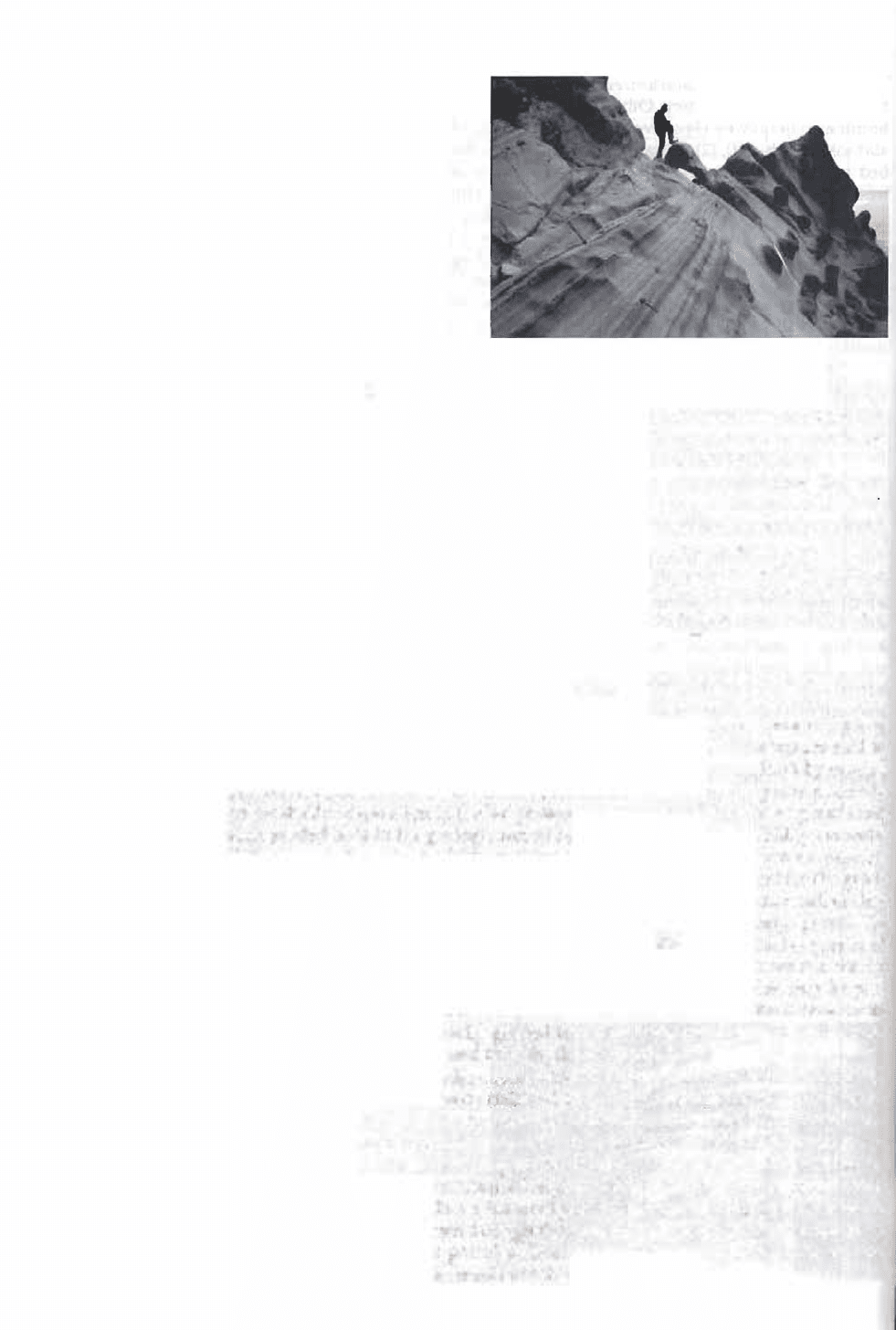
80
Chapter 4 I Sedimenta Structures
Figure 4.6
Parallel laminae (arrows) in fine-grained sandstone, Elkton For
mation (Eocene), southern Oregon coast. The dark, rounded
objects in the lower right corner of the photograph are
concretions.
1965; Allen, 19; Bridge and Best, 1997). They Cl1 also form by wind transport (e.g.,
McKee, Douglass, and Rittenhouse, 1971; Hw1 ter, 1977); however, wind-formed
parallel laminae are not common. Thus, laminated bedding can develop in a variety
of environments, and its presence is not a tmique environmental indicator.
Once formed, parallel laminae are commonly preserved unless they are
deposited in an environment in which sediment is being actively reworked by
organisms. The burrowing and feeding activities of organisms in many environ
ments can quickly destroy lamination. Laminae have the greatest potential for
preservation in reducing or toxic environments, \V here organic activity is mini
maC or in environments where deposition is so rapid that the sediment is buried
below the depth of active organic reworking before organisms can destmy strati
fication.
Graded Bedding. Graded beds are sedimentation units characterized by distinct
vertical gradations in grain size. They range in thickness from a few centimeters to
a few meters or more and commonly have sharp basal contacts. Beds that show
gradation from coarser particles at the base to finer particles at the top are said to
have normal grading (Fig. 4.7; 2.8). Normal graded bedding can form by several
processes, e.g., sedimentation from suspension clouds generated by storm activity
on the shelf or deposiion in the last phases of a heavy flood, but the origin of most
such raded beds in the geologic rocord has been attributed to turbidity currents.
Differences in the rate at which particles of different sizes settle from suspension
during the waning stages of turbidity current flow appear to account for the grad
ing, but the exact maer in which the grading process operates is not well under·
stood. The graded materials may be mud, sand, or, more rarely, g1·avel. As
discussed in Chapter 2, some graded turbidite units display an ideal sequence of
sedimentary structures, called a Bouma sequence (Fig. 2.8), but more commonly
the sequence is trtmcated at the top or bottom. The basal A division may pre
sent, but some or all of the overlying divisions may be absent; or the A dvision it
self may be missing. Normally graded turbidite beds commonly occur in thin,
repetitious successions referred td as rhythmic bedding.
Reverse grading can also occur but is much less common than normal grad
ing. Reverse grading has been attributed to two types of mechanisms: (1) disper
sive pressures and (2) kinetic sieving. Dispersive pressures (Chapter 2) are
believed to be proportional to grain size. a sediment of mixed grain size, the
higher dispersive pressures acting on the larger particles tend to force them up
into the zone of least shear. Alternatively, reverse grading may be explained by a
kinetic sieve mechanism. In a mixture of grains dergoing agitation, the smaller
grains presumably fall down through the larger grains as grain motion opens up
spaces between the larger particles. Overall, reverse grading is a relatively rare
phenomenon, and its origin is still poody understood.
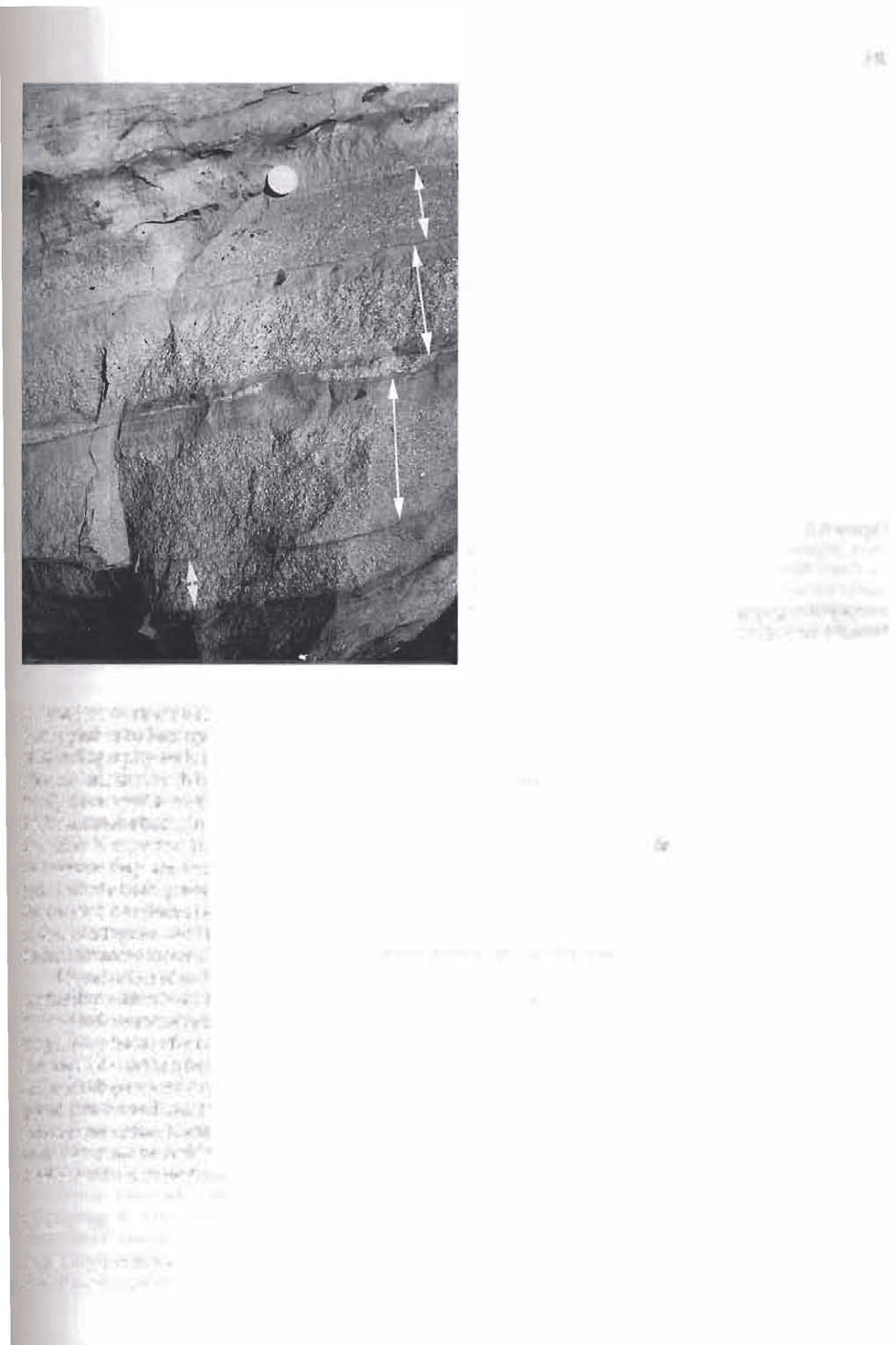
4.3 Stratification and Bedforms
81
Figure 4.7
Normal graded bedding in the Cretaceous Hudspeth
Formation, north-central Oregon. Four graded beds
(arrows) are visible.
Massive (Stcturelesst Bedding. The term massive bedding is used to describe beds
that appear to be homogeneous and lacking in internal structures (e.g., Fig. 4.8). Use
of -radiography techniques (Hamblin, 1965) or etching and staining methods
often revea ls that such beds are not truly massive but rather that they contain very
faintly developed structures. Nonetheless, one occasionally finds beds, particularly
thick sandstone beds, In which internal structures cannot be recognized even with
the aid of X-ray staining techniques. Such beds are rare, which is fortunate for
us becau they are very difficult to explain. Reported occurrences of massive
s include both graded bed rmits in some turbidites, which may lack internal
structures other than size grading, and certain thick, nongraded sandstones such
those in Figufe 4.8. The beds in Figure 4.8 appear massive on a large scale but
do contain some internal layers.
Liquefaction of sediment owing to sudden shock or other mechanisms short
ly afr desition has been suggested as a means of destroying origal stratifica
t
ion prod uce massive bedding. Otherwise, it is assumed that lack of stratification
is a primary feature that occurs in the absence of traction transport and results from
ry rapid deposition from suspension or deposition from very highly concentrated
iment dispersions dttring sediment-gravity flows. It has commonly been sug
ges that the sediment is dumped very rapidly without subsequent reworkg to
fonn a more or less homogeneous mass. Kneller and Branney (1995) propose, how
er, tha t massive turbidite deposits could also form by gradual aggradation of
sand beneath sustaed steady or quasi-steady, high-density turbidity currents.
Bedforms
Anyone who has examined the sandy bed of a clear, shallow stream has certaly
noced that the bed is rarely perfectly flat and even. Instead, it is commonly
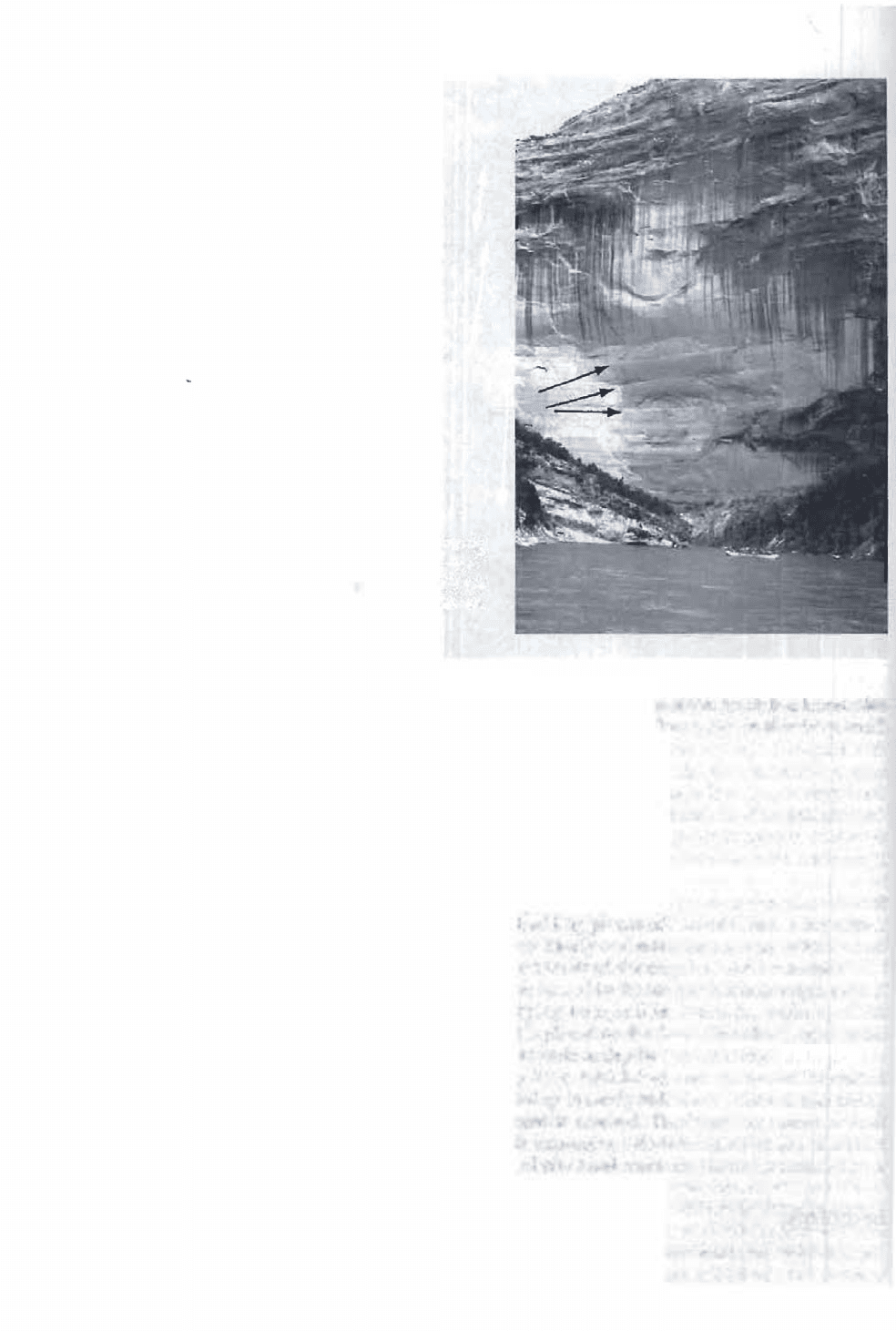
82
Chapter 4 I Sedimenta Structures
Fire 4.8
Thick, massive-bedded Jurassic/Triassic sandstones exposed along
the Green River, Utah. Bedding planes (arrows) divide the lower
part of the section into several massive-bedded units. The vertical
stripes in the upper half of the photograph are weathering stains.
Note the river raft for scale.
marked by ripples and similar bedforms of various sizes. Such bedforms also
occur in eolian and submarine environments where they range in size from small
ripples a few centimeters long and a fraction of a centimeter high to gigantic eo
lian sand dunes and undersea sand waves tens to hundreds of meters long and
several meters to several tens of meters high. If we carefully dissect a ripple ex
posed on the dry bed of a stream to reveal its inteal structure, we almost in vari
ably find internal fine-scale cross-laae that dip in a downcurrent direction.
Clearly, there is a close genetic relationship between flujd-flow mechasms, rip
ple bedforms, and cross-lamation.
The preservation potential of ripples is relatively low; therefore, they a not
extmely common features on the edding planes of ancient sedimentary rocks.
On the other hand, cross-beds are exceedingly common in many ancient sandstone
successions. In an attempt to better w1derstand the origin of bedforms and cross
stratification, many investigators have turned to the sudy of sediment transport in
flumes. Flumes are long, slightly sloping lroughs ftted with glass sides to allow
observation. Sd or other sediment is placed on the floor of the flume, and water
is constrained to flow over the floor at various depths and velocities.
Numerous flume experiments have established that under unidirectional
fluid flow, small ripples begin to develop in sandy sediment as soon as the critical
entrainment velocity for the sediment is reached. The exact sequence of other
kds of bedforms that develop with increasing velity depends upon the grain
size of the material. If flow is over a of sediment ranging size from about
0.25 mm to 0.7 (medium to coarse sand), for example, the succession of bed
forms illustrated in Figure 4.9 is generated, beginning with ripples. Ripples are the
smallest bedform, ranging in length from about 5 to 20 em and in height from about
0.5 to 3 em. Thus, they have a ripple index (ratio of ripple length/ripple height)
ranging from about 8 for coarse sand to 20 for fine sand. They form in sediment

Flow direction
Ripples
Dunes
Plane (flat) bed
Chutes and pools
LOWER
FLOW
REGIME
UPPER
FLOW
REGIME
4.3 Stratification and Bedforms
83
Figure 4.9
The succession of bedforms that develops during
unidirectional flow of sandy sediment (0.25-0.7
mm) in shallow water as flow velocity increases.
[Modified slightly from Blatt, H., G. V. Middleton,
and R. Murray, 1980, Origin of sedimentary rocks,
2nd ed., Fig. 5.3, p. 137. Reprinted by permission
of Prentice-Hall, Englewood Cliffs, N.j.]
ranging in size from silt (0.06 nun) to sand as coarse as 0.7 mm. Larger bedforms
with spacing, or wave length, ranging from under 1 m to over 1000 m are called
dunes (Ashley, 1990). Dunes are similar in general appearance to ripples except
for size. They form at higher flow velocities in sediment ranging in grain size from
e sand to gravel. The ripple index of dunes ranges from about 5 in finer sands to
50 in coarser sediment. In the lower part of the dune stability field, ripples may be
superimposed on the backs of dunes.
e hydraulic conditions that generate ripples and dunes take place at
Fude numbers <�1. Under these flow conditions, either e water surface
shows little disturbance or the water waves are out of phase with bedforms, and
ow is said to be in the lower ow regime {Simons and Richardson, 1961). Down
sam migration of ripples and dunes leads to formation of cross-lamination that
ps downstream at angles of up to about 30°. With further increase in flow veloc
i, dunes are destroyed and give way to an upper flow regime stage of ow,
which takes place at Froude numbers >�1. Sheetlike, rapid flow of water takes
place, which generates surface water waves that are in phase with bedforms.
tense diment transport results, over an initially relatively flat bed, during what
referred to as the plane-bed stage of flow. Plane-bed flow gives rise to internal
planar lamination in which individual laminae range in thickness from a few mil
limeters to a few centimeters. At still higher velocities of flow, plane beds give way
to andunes, which are low, undulating bedforms up to 5 min length. Anti dunes
form in very fast, shallow flows. They migrate upstream during flow, giving rise
to low-angle ( <10°) cross-bedding directed upstream.
The charactestics of bedforms that develop under unidirectional flow are
szed Table 4.2. Two-dimensional dunes are generally straight-crested
d whose shapes can be adequately descbed a two-dimensional plane oriented
plel to e flow direction. Three-dimensional dunes are characterized by curved
fac and scour pits, and their shapes must be descbed three dimensions.
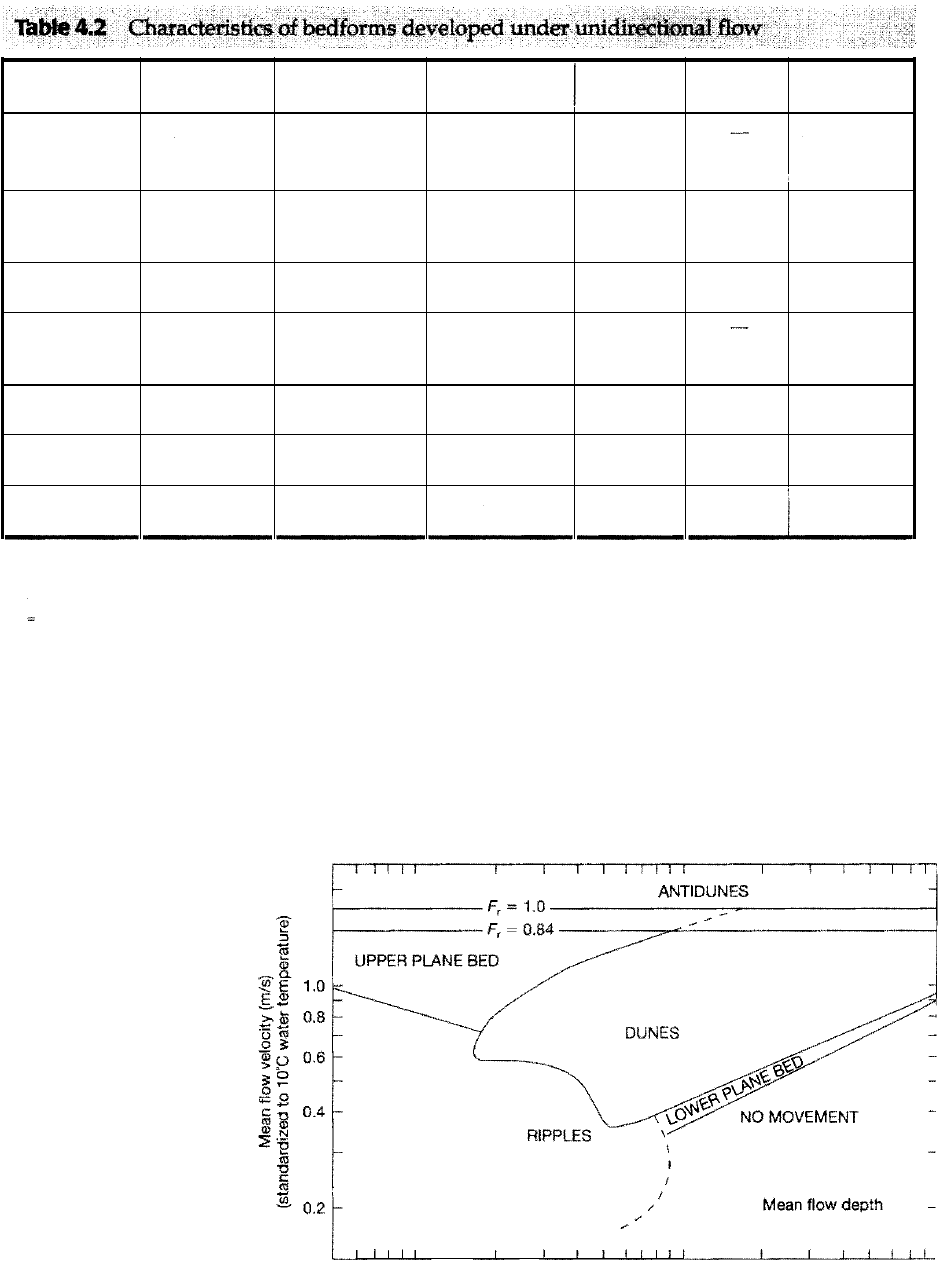
84
Chapter 4 I Sedimenta Structures
·��.· �a��fQ fel�dd.��
·
·
·
,;•
,
,
_
--_,_ _
.
·i, ,_- -•-: _
·
'"-" . _: _-
--
-- "
, -:
.
'
·
_
.
'
"
:
"
_,,
.
:'tc,·- •·
, ·' ,'
·
.
.
•
_,
.
_
.
·
• •
::;
Lower
Upper
Ripples
2D dunes
3D dunes
plane bed
plane bed
Length 0.1-0.2 m
a few lOs of em
a few lOs of
-
(spacing)
to lOOs of m em to lOs of
m (or more?)
Height
a few em
em to a few lOs of em
- -
lOs of m
to afewm
(or more?)
Ripple index relatively low
relatively
relatively
-
-
(length/height) high low
Plan geometry strongly
straight/
strongly
-
irregular/
sinuous and
irregular/
short-crested long-crested short-crested
Characteristic
low
low I moderate
moderate/high
low
high
ow velocity
Characteristic
> afew cm
>afew dm
>a few em
all
all
flow depth
Characteristic 0.03-0.6mm >0.3mm
>0.2mm
>0.6mm all
sediment size
Anti dunes
lOs of cm-m
em-lOs of em
relatively
high
long-crested
and short-
crested
high
shallow
lows
I
all
urc: Modified from Harms; J, C., J. B, Southard, and R. G. Walker, 1982, Structures and sequences in dastic rocks: S. Econ, Paintologifs and
Mineralogists Short Coure No.9. ·rable 2-1,
p
. 2-llr re
p
rinted by
p
ermission ofSEPM, Tulsa, Okla.
2D = Two dimensional
30 Three dimensional
Effects of Grain Size and Water Depth on Bedfo Development
Experimental studies show that the succession of bedfos that develops at a
given water depth during fluid flow depends not only upon ow velocity but also
upon
grain size; therefore, the succession of bedforms shown in Figure 4.9 do
es
not occur in sediment of all parcle sizes. Figure 4.10 shows the relationship of bed
forms to flow velocity and grain size at a water depth ranging from 0.25 to 0.40 m.
re 4.10
Plot of mean flow veloci
against median sediment size
showing the stability fields of
bed phases. Note that the rec
ommended terminology for
bedforms is (1 ) lower plane
bed, (2) ripples, (3) dunes (all
large-scale ripples), (4) upper
plane bed, and (5) antidunes.
F, = Froude number. [After
Southard, J. B., and L A.
Boguchwal, 1990, Bed configu
rations in steady unidirectional
water flows. Part 2. Synthesis of
flume data: ]our. Sed. Petrolo
gy, v. 60, Fig. 3, p. 664,
reprinted by permission of So
ciety for Sedimentary Petrolo
gy, Tulsa, Okla.]
2
.0
0.
2
t
.
-
L
��
--
�
---
-
-
L��
�
/
�
-
L
--
L
M
_
e
_
a
_
n
�
fl
-
o
w
�
d
-
e
�
p
t
_
h
-
L
�
0.20.40 m
I I I I I
I
!
I
l
I
0.1 1.0
Median siment size (mm)
(standardized to 1 o·c
w
ater tem
p
erature)
